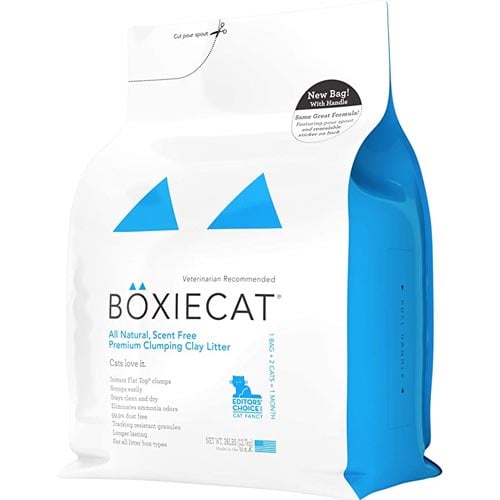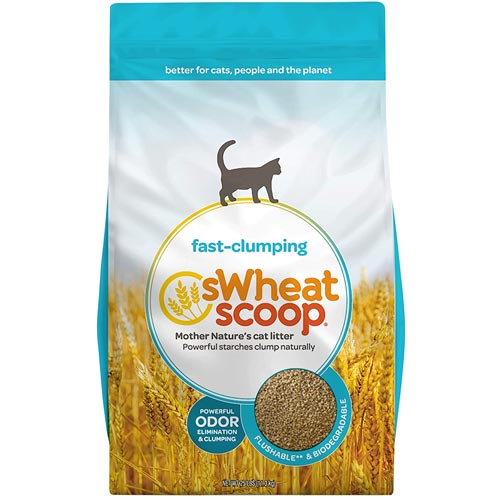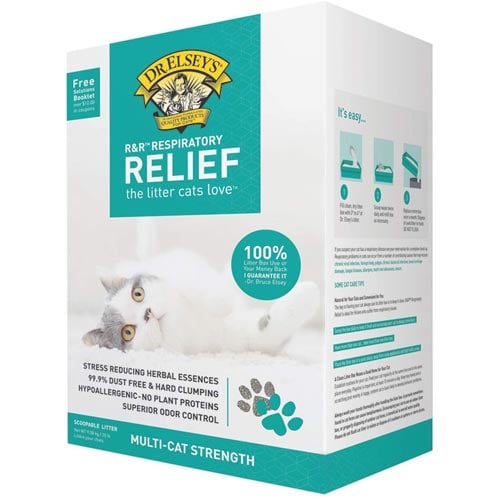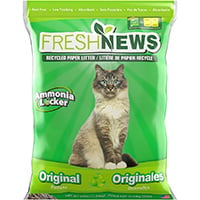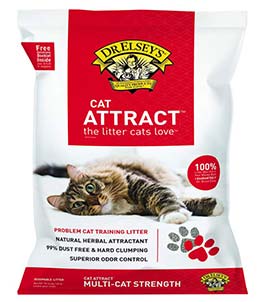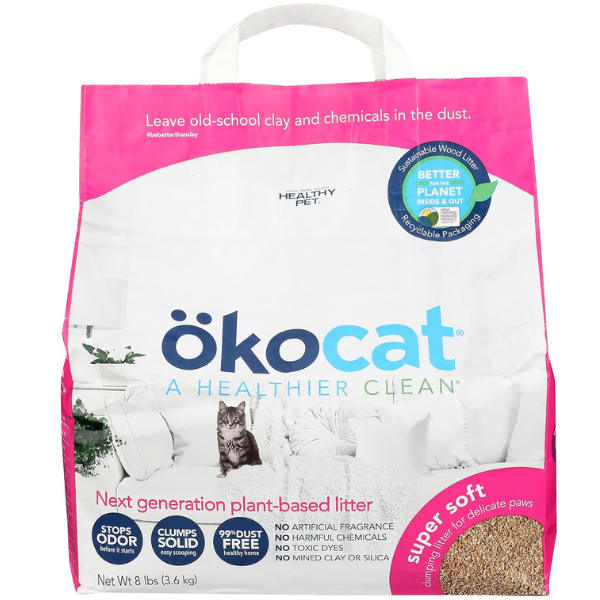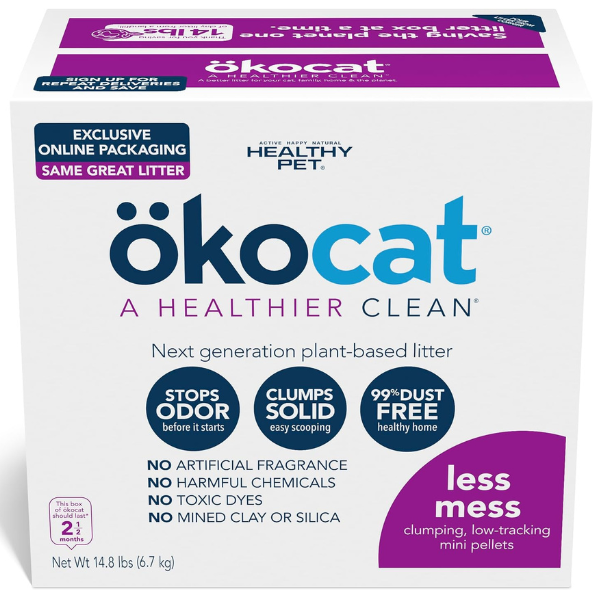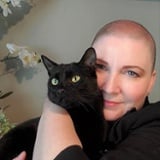 75 years ago, cat litter options were limited. There was only one brand of litter called Kitty Litter, which was made from a type of absorbent clay. Its main compound was calcium bentonite, which is also known as Fuller’s earth.
75 years ago, cat litter options were limited. There was only one brand of litter called Kitty Litter, which was made from a type of absorbent clay. Its main compound was calcium bentonite, which is also known as Fuller’s earth.
Back then, your choices were this, sawdust, or sand. Nowadays, cat litter is a multi-billion-dollar industry.
There are a variety of materials and textures available, from clay to nut shells, shaved wood, silica, recycled newspaper, and more.
But just because litter is marketed for cats doesn’t mean it’s the best choice for your cat. It’s not just about preference. Some litters can be physically uncomfortable for your cat to use. They can even potentially be harmful to their health and yours.
I will say upfront, that more research needs to be done on the various types of litter and how they affect our cats’ health. Unfortunately, the information available to consumers is often limited and conflicts depending on the source. It’s important for each of us to stay informed if and when new research comes out.
It’s also challenging because just about every type of litter has pros and cons. That’s why it’s helpful to study up. Everyone has a different situation, meaning there’s no “this is the only litter you’ll ever need” option. You’ll have to make some sacrifices in order to get some gains. Your priorities may be different than mine, and they may change throughout your cat’s life.
Let’s get the scoop on kitty litter!
Things to Consider When Choosing a Litter for Your Cat
Skip to section:
Pros and cons: Clumping vs non-clumping litter
Pros and cons: Scented vs non-scented litter
Our recommended cat litters (including litter for mobility issues, etc.)
Clumping Litter Versus Non-clumping Litter
Clumping litter absorbs moisture more rapidly, turning pee spots into tight clumps that you can easily scoop and toss. It’s the cleanest option in terms of being able to remove the stinky bits quickly.
Clumping litters are not created equal. The firmness of the clump matters. If it’s a loose clump, you’ll have a hard time removing all the ick. It will crumble and leave wet bits in the box.
A firm-clumping litter is best.
Non-clumping litter absorbs moisture more slowly. You can remove poop pretty easily. But pee doesn’t clump. It just saturates the litter. Instead of scooping pee daily, you have to dump all the litter and replace it every couple of days.
Litter boxes with non-clumping litter can be much more smelly since that urine stays in the box, making it less appealing for you and your cat.
Our vote:
Go with clumping litter. It may cost a little more, but it’s easier to keep clean, especially if you live in an apartment or condo and can’t easily carry the litter box out to the garbage can to dump it every couple of days.
Scented Versus Unscented Litter
Scented litter products have artificial scents or deodorizers added, in an attempt to mask the pee and poop smell.
Unscented litter is made without additional scent agents and is often referred to as ‘odorless’ litter.
Just because there’s no “added” scent doesn’t mean the litter is truly odorless. It will often retain the smell of the products it’s made from. And not all of those are scent-free, especially to your cat.
The biggest offender can be litter made from pine. I have extremely sensitive sinuses, and I’ve tried multiple unscented litters that were still too much for me. That means they were way too much for my cats.
A cat’s sense of smell is up to 40x more sensitive than ours. With nearly 200 million odor receptors in their nose, what might seem like a lightly scented litter to you could be overwhelming and off-putting to them. It can be even more of an issue if your litter boxes are enclosed or in small spaces. This can lead to house soiling because a super-smelly area (even if it’s a good smell) isn’t a natural place for a cat to pee and poop.
Our vote:
Skip the scented litter that tries to cover up the stink. The best way to avoid a smelly box is through regular scooping!
Cat Litter Consistencies
Clay Litter
Clay is one of the faster-absorbing litters on the market and one of the most popular. It closely resembles what cats would CHOOSE to use in the wild — sand or dirt that allows them to dig and bury their pee and poop.
After all, when you’re a predator, you don’t want your potential lunch to smell you in the area and take off. And when you’re prey, you don’t want to be lunch to the predator who followed your scent right to you. Cats are both, so they like to dig and bury.
On the downside, clay litter can often be very dusty. This is problematic for cats and people with respiratory issues.
The fine grain that makes it so appealing to cats can lead to a lot of tracking — it can stick to paws, be easily kicked out of the box, and tracked throughout the home. This is a turnoff for many. It took me years to finally make peace with the fact that the most appropriate choice for my cats, in my opinion, meant I would have to suck it up and deal with tracking.
Many people understandably have concerns about the sustainability of clay litter. It’s not a renewable material and can add to landfill waste. Unfortunately, this is the case with many litter types.
Crystal (Silica) Litter
Crystal litter is made from silica crystals. You’ve seen silica packets in household products. They absorb moisture. Silica/crystal litter is the same idea. It’s incredibly absorbent.
While it doesn’t clump, meaning you have to toss the entire box instead of scooping clumps of pee, it absorbs well enough that you don’t end up with soggy litter. Some claim to last a full month before replacement is needed. It’s also known to control odor quite well. And it’s low dust.
But there can be drawbacks. Some crystal litter granules are quite large and sharp, making them uncomfortable or even painful on kitty paws. This is especially true for cats who have mobility issues, osteoarthritis, or are declawed.
Concerns have also been raised about the safety of silica. Remember, anything your cat touches can be ingested as they lick their paws. And digging around in any litter can create dust or small particles that can be inhaled. Some types of silica can be dangerous when inhaled.
I avoid silica litter, but this is certainly an area where more research is needed. There are a few studies for both cats and humans, where silica-based litter was deemed dangerous. This article explores the safety of Pretty Litter, and they deem it isn't.
Paper Litter
These litters are made out of recycled paper. Some claim to be chemical-free and super-absorbent. A benefit of this litter is its sustainability.
It comes in a pellet form, a texture often used by veterinarians after surgical procedures so the smaller litter particles don’t get stuck in surgical wounds. It's also helpful for long-haired breeds who tend to drag their fur through wet litter that then sticks to their fur.
However, for everyday use, pellet litters aren’t necessarily ideal. The larger pellet size is different than the fine-grain sand or soil cats would choose in the wild. It can be painful on sensitive paws and cause instability for senior cats or those with mobility issues.
Other Natural Litters
This is a newer and continually evolving category. I’ve seen litters made from pine, wheat, tofu, walnut shells, and more. Natural litters are typically biodegradable. Some use sustainable sources. Beyond that, each has their own pros and cons.
Odor control varies dramatically, as can dust. Many aren’t clumping, which means it’s harder to keep the box clean and sanitary. The natural scent of some, like the pine litter I mentioned earlier, can be quite strong. Grain size and sharpness can vary. Walnut shells feel different than tofu pellets.
Dangers with corn-based cat litters:
While research is limited at this time, there’s some concern over corn litters because corn products are prone to a specific toxic mold called aflatoxin. It can result in significant health issues for cats, as well as for those with asthma and COPD, and immunocompromised and elderly people.
The mold develops in moist conditions which can be the litter box itself or the place you’re disposing of the used litter, like your Litter Genie.
Here are a few warnings about the dangers of of this type of mold for pets and people:
- FDA: Aflatoxin Poisoning in Pets
- Michican Government: Aflatoxin Poisoning in Pets: What You Need to Know
- World Health Organization: Mycotoxins
- National Cancer Institute: Aflatoxins
Also keep in mind that litter made from food products, like corn or tofu, can attract pests.
So, should you try a natural litter? It’s really a matter of checking out your options and thinking about you and your cat’s specific needs.
Our vote:
I continue to be a fan of good-quality clumping clay litter. That doesn’t mean I’m unwilling to change. As new litters come on the market, I do a little research and give them a try.
Other Kitty Litter Factors to Consider
Dust
Dust isn’t just a factor in keeping the surfaces of your home clean. It’s also important for respiratory health. Feline asthma is a relatively common issue in veterinary medicine and dust from cat litter can irritate an asthmatic cat’s airways, which can cause or worsen an asthma attack.
Litter dust can also be challenging for people with respiratory issues. This makes low-dust options an important consideration for cats or people with asthma and other respiratory concerns.
Tracking
No one wants to find kitty litter outside the box and tracked through their home. I get it. It’s gross. But you may find the benefits of tracking-prone litter outweigh the cons. For me, it’s the clumping, relative safety, and the fact that it most resembles what cats would choose in the wild that makes me willing to deal with tracking.
 There are things you can do to manage the mess, like keeping a little broom and dustpan or hand vac near the box for a quick clean up after scooping, keeping boxes out of major walkways, and using a litter mat or shaggy bathmat in front of the box to collect stray litter. I find that mats with long grooves do a good job of trapping litter, like the one featured above.
There are things you can do to manage the mess, like keeping a little broom and dustpan or hand vac near the box for a quick clean up after scooping, keeping boxes out of major walkways, and using a litter mat or shaggy bathmat in front of the box to collect stray litter. I find that mats with long grooves do a good job of trapping litter, like the one featured above.
Cost
There can be huge differences in price, especially between clumping and non-clumping litters. That doesn’t mean they’re less expensive in the end. Remember, some litters have to be completely dumped and replaced as often as every few days whereas others are scooped and topped off as needed, only needing to be completely dumped for deep cleaning every month or so.
There’s also the emotional cost. If a cheaper litter is causing stress for your cat or not meeting their instinctual needs well, they could start house soiling. This means you’re stressed too. There’s a cost for that.
Weight
Kitty litter can be very heavy. If you have to carry it down the block or up a few flights of stairs, you may want to look at the lighter formulas and smaller package sizes.

Cat Litter Recommendations
Boxiecat is my favorite.
Why you might like Boxiecat Premium Clumping Clay Cat litter:
- 100% all-natural clay
- Low-dust
- Clumping
- Unscented
- Hypoallergenic
- Low-tracking
Why you might like Dr. Elsey's Ultra Cat Litter:
- Clay
- Low-dust
- Clumping
- Unscented
- Hypoallergenic
- Low-tracking
Why you might like sWheat Scoop Cat Litter:
- Made from biodegradable renewable wheat
- Natural
- Clumping
- Low-dust
- Unscented
- Lightweight
- No dyes, perfumes, or chemicals
- Flushable (though most plumbers seem to recommend against it)
Why you might like Dr. Elsey’s Respiratory Relief Cat Litter
- Clay
- Low-dust
- Clumping
- Hypoallergenic
- Contains stress reducing herbal essences
- Also available in crystal, non-clumping variety
Why you might like Fresh News Cat Litter:
- Made from recycled newspaper
- Low-dust
- Unscented
- Non-allergenic
- Natural
- Biodegradable
- Low-tracking
Why you might like Dr. Elsey’s Precious Cat Attract Cat Litter:
- Clay
- Low-dust
- Unscented
- Clumping
- Contains specific proprietary blend of herbal essences that act as an attractant to entice a cat or kitten to the litter
Why you might like okocat's Super Soft Clumping Wood Cat Litter:
- No artificial fragrance
- No harmful chemicals or toxic dyes
- Biodegradeable
- Clumping
- Soft on sensitive paws, making it great for cats with mobility issues, arthritis, or declawed cats
Why you might like okocat's Clumping Wood Cat Litter:
- No artificial fragrance
- No harmful chemicals or toxic dyes
- Sustainably sourced
- Clumping
- Mini pellets are much smaller than standard pellets, making it more comfortable for cats who can't use fine-grain litter



